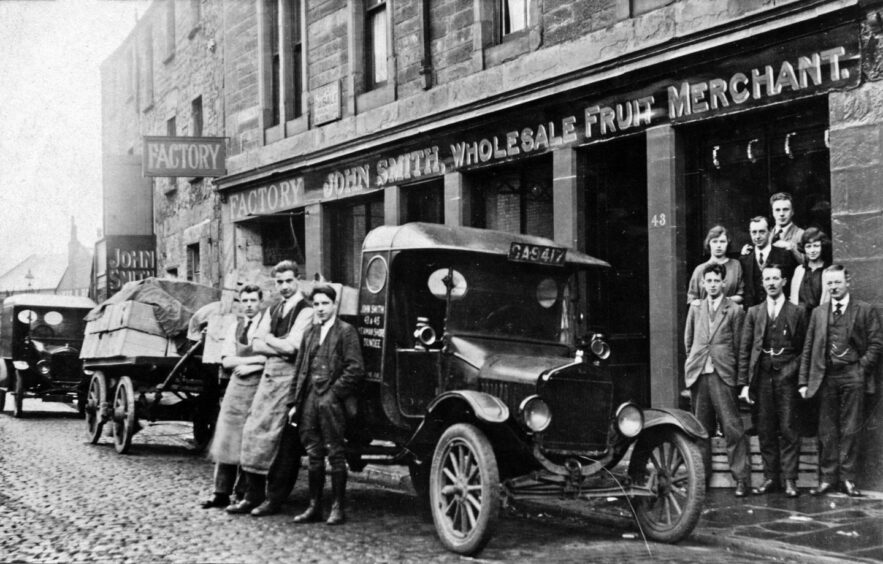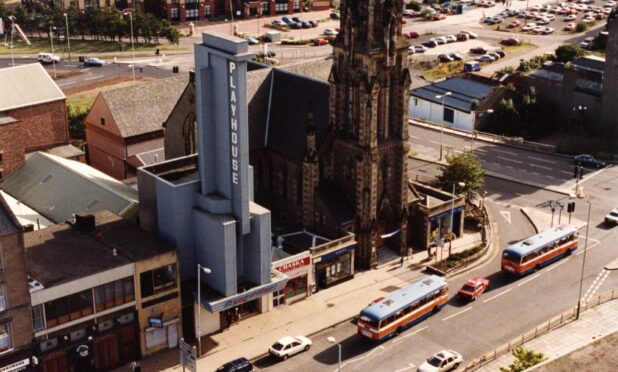
These nostalgic black and white images capture scenes of Dundee life from the 19th Century to the 1960s.
Bygone Dundee by Bernard Byrom contains more than 200 photographs and postcards of people and buildings in a more innocent time.
The 144-page book is a delightful treasure trove filled with snippets of information.
Vanished views, changed landscapes and departed characters are captured.
These were the days when jute mills dotted the Dundee skyline and trams ruled the roads and took people to work, to the shops, to the football.
The Royal Arch was still standing and there was a submarine base.
The Fifies were still in daily use transporting Dundonians across the Tay.
We see many business which are long gone, like John Smith, the fruit merchant in Yeaman Shore, and John Soutar’s corner shop at Hawkhill.
A stopping passenger train rumbles through Dundee East Station.
You can see men in suits.
Greenmarket on a market day was crowded.
You can feel the past.
Submarine base
Bernard said: “In 1908 the Admiralty began looking for a place on the east coast of Scotland to build a submarine base, finally settling on Dundee.
“They took a five-year lease from September 1 1909 and the 7th Submarine Flotilla left Portsmouth and arrived in King William IV Dock on November 29.
“This lease was extended many times and finally expired on September 30 1920.”
Dundee waterfront
The river is behind the photographer in this view looking northwards from the Esplanade in Edwardian days.
Bernard said: “The hipped roof of the building below street level belongs to the North British Railway’s Tay Bridge Station.
“The buildings behind it at street level are various goods sheds belonging to the rival Caledonian Railway, whose West Station lies just beyond them, crowned by its magnificent clock tower.”
Bellefield Avenue
Bernard said: “Bellefield Avenue is lined with dignified four-storey tenements built in the early 1890s and leads northwards from Magdalene Yard Road up to Seafield Road.
“This view is from the bottom end of the road.
“The garden walls are nowadays devoid of their ornate cast-iron railings, which were no doubt ripped up during the Second World War to make armaments.”
John Smith
Bernard said: “John Smith was in business as a wholesale fruit merchant with premises at 43 and 45 Yeaman Shore alongside Dundee West Station.
“In 1927 he moved from Yeaman Shore to more commodious premises at 31 Crichton Street.”
Greenmarket
A corner of the Greenmarket on a market day.
Bernard said: “North of Earl Grey Dock and south of the High Street, this was Dundee’s foremost marketplace and venue for fairs.
“The building on the right was the old custom house.”
Boots the chemist
Bernard said: “Strathtay House on the corner of Reform Street is not only recognisable today but is still occupied by Boots the chemist.
“The buildings in the High Street on the nearside of Reform Street have also survived and, now refurbished, form an attractive north side of the High Street.
“The date cannot be later than 1956 because there is a tram in the picture.”
Murraygate
Bernard said: “Approaching down Murraygate, Tram No. 44 is about to enter the High Street on its way to West Park, on the Perth Road.
“This tram was built open-top in 1902 but by the time of this picture the top deck had been enclosed for many years.”
John Soutar’s corner shop
Bernard said John Soutar’s corner shop was at 72 Hawkhill.
He said: “The posters around the doorway indicate the political stories of the time, which dates the picture to around 1907 or 1908.
“The shop was situated on the corner of Park Wynd, a little way up the hill from West Port.”
Barrack Street playground
Bernard said: “The children’s playground in Barrack Street around 1914 with the Royal Infirmary in the background and Dudhope Castle on the right.
“It was believed that the two cannons in the picture had been captured from the Russian army during the Crimean War.”
Balgay Park
Bernard said: “The footway on the bridge in Balgay Park was originally constructed of timber and had a width of eight feet.
“The bridge is about 42 feet above the roadway.
“The bridge is seen here around 1910 but by the 1920s it had fallen into disrepair, largely because of a dispute between council departments over who was responsible for its upkeep.”
Camperdown Works
Workers streaming out of the Cox Brothers’ Camperdown Works on their dinner break.
Bernard said: “It was the largest jute mill in the world and by 1900 employed more than 5,000 workers.
“The entire works closed in 1981 and much of the site has been redeveloped with housing and entertainment facilities.”
Baldovan Station
Baldovan Station was opened in 1831 on the Dundee and Newtyle Railway.
Bernard said the original line included three rope-worked inclined planes and a tunnel through Dundee Law.
He said: “In 1907 Downfield became the northern limit of Dundee Tramways.
“In this 1908 photograph, the tram is at the terminus and beyond it Strathmartine Road bends round to the left to cross the railway on an overbridge which is just visible on the left of the picture.”
Stobswell
Bernard said: “Housing was built in Stobswell by the city’s jute barons in the 19th Century to accommodate workers in the textile mills in the area.
“A major road junction was constructed here, and in this picture the cameraman is standing in Dura Street.
“Mains Loan is on the left.
“The tramlines are running from Albert Street on the right, to begin the ascent of Forfar Road past the railings on the left.”
Baxter Park in Bygone Dundee…
Bernard said: “Baxter Park was donated to the citizens of the city by Sir David Baxter and his two sisters, Mary Ann and Eleanor.
“The land was acquired in 1861, on a site that was at the time on the edge of the city, and it was laid out at a cost of £4,000 (about £4m today).”
- Bygone Dundee by Stenlake Publishing is out now.
























Conversation